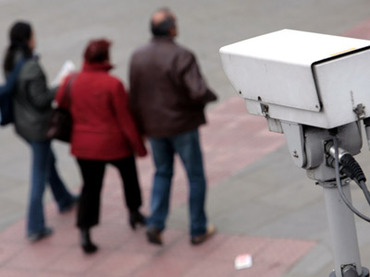
http://rt.com/news/identify-walk-system-britain-668/
21 September, 2012

A new biometric “gait recognition” system has been developed by Britain’s National Physical Laboratory, meaning that individuals can now be recognized and located by their “signature” walk.
Serious privacy concerns have been aired about the system and its potential
surveillance applications.
New Scientist reports that NPL, which collaborated with the Center for
Advanced Software Technology (CAST), the BBC and BAE Systems, developed a new
system through which a person’s walk could be identified. The tracking system
combines a computer model of the NPL building with feeds from each on-site CCTV
camera.
In each video frame, the system separates an individual’s silhouette from its
background. The rise and fall of head height is recorded, and the pattern it
forms can be represented by a set of numbers. This is linked to the person’s
identity. A computer can then produce a list of all the other places that the
person has visited, and the occasions they have been there.
Iris scans and facial recognition systems are seen as insufficient when it
comes to identifying individuals from a longer distance. These methods require a
“cooperative subject” and high-quality imaging. Standard CCTV is too
low-resolution to pick out distinctive features, but the gait-identifying
development could give it much more advanced surveillance capabilities.
“This technology poses a real threat to privacy and in the coming years it will be used for marketing purposes as well as supposed public safety. Personal data goes far beyond writing down your name and address now and the law urgently needs revising to reflect this,” Nick Pickles, director of the UK’s Big Brother Watch told RT.
Simultaneous research has been carried out by Professor Martin Hofmann and
colleagues at the Technical University of Munich. They have developed an even
more intrusive version that takes information from a person's image, such as
shadows on their clothing, creating a considerably more detailed “signature”.
Additionally, Professor Daigo Muramatsu and colleagues at Osaka University
have been conducting research on how people can be identified from different
camera angles. He believes the research could also have “commercial
applications,” according to New Scientist.
Hoffman suggested that it could be used to identify bank robbers who had
their faces covered.
However, Nick Pickles stated, “Rather than finding new ways to identify
innocent people, we should be asking why mass surveillance has failed to make
people any safer.”
Earlier this month RT reported the FBI’s installation of the $1-billion Next Generation Identification system, which is able to recognize faces, across America. This is an “upgrade” to the current Integrated Automated Fingerprint Identification System, and already has incredible surveillance capabilities over the innocent as well as guilty.